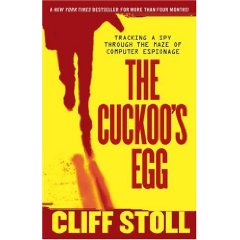- | Home |
- Company |
- Contact |
- News |
- S/ware Eng |
- Standards |
- Academic Support |
- Documents |

- | Requirements |
- Validation |
- RTOS |
- Analysis |
- Software |
- Resources |
- Products |
Title: The Cuckoo’s Egg
Review Date, Jan 2009 |
 |
A fascinating story that reads like a Hollywood film except it all actually happened! Even the names that were changed to protect the guilty and innocent have been corrected with the real names.
This is the story of some of the original pre-internet cyber spying where truth is stranger than fiction and the “hero” is initially an unwilling participant.
The author is a Astronomy student who used computers for astronomical calculations back in the days (circa 1980) where if you wanted to get a computer to do something you had to write the program yourself and the VAX was still king. He noticed a 75cents discrepancy that periodically appeared in a system accounting application. In those days you paid for computer time by the CPU cycle resources and time slices. He wasn't thinking of a hacker but a faulty program.
The story progresses with the author chasing these hackers electronically across the world’s telephone system and finding it almost impossible to get the FBI, CIA or US military show any interest in the fact that the hacker(s) have systematically got into many top secret military research establishment computers
Eventually, the story covers many months, the Law Enforcement and Security Forces do take an interest however getting the US authorities to do anything let along the foreign Police is a nightmare as the “crimes” don’t actually exist. Computers had really only come into existence 30 years before and inter-connecting them had only started a decade before. Viable home computers had only appeared within 5 years of these events.
In the end, as far as the author knows, the loop-holes were closed and the perpetrators at least the ones they knew of and could trace are brought to justice. Some, believed to be KGB agents, just disappeared. They still do not really know how much these hackers discovered and passed on or which other computers they got into.
This story is a good read and will bring back fond memories of modems, leased lines and the very early days of computer networking before the internet was the global phenomenon it is today. Programs seldom heard of these days (except by Linux/Unix users) like telnet and the subtle differences between BSD and AT&T Unix.
There is enough technical detail without being too nerdy but complete enough for the rest of use to know exactly what is happening. The thrill of the technical battle is clear as is the frustration with trying to explain “science fiction” to Police, FBI and CIA when the days when the average CIA officer was closer to Inspector Morse than Agent Molder.
It is entirely unpretentious and good book for Christmas or something to read on holiday. Highly recommended